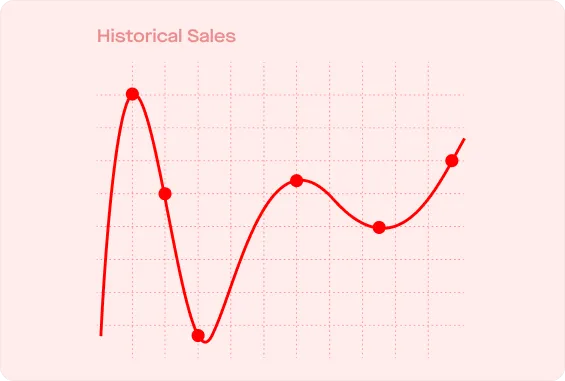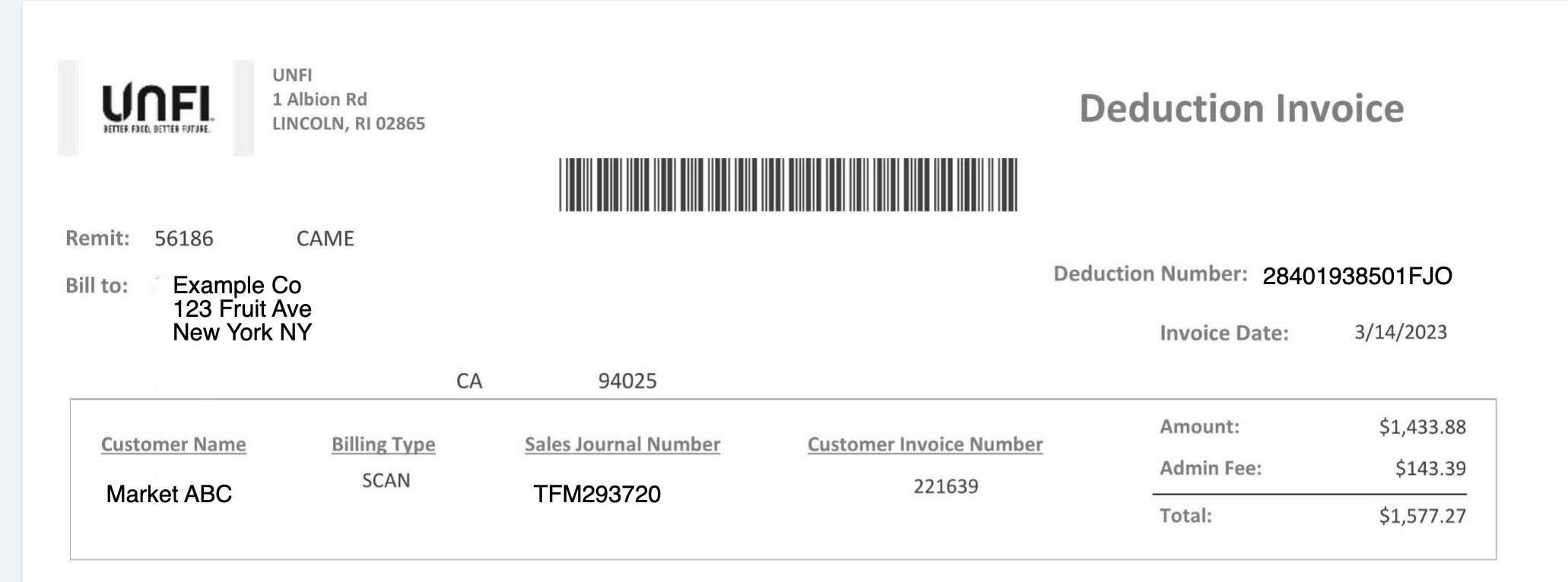The Playbook to Manage & Automate Deductions



The Playbook for Managing and Automating Deductions
What are CPG Deductions and why do they occur?
CPG deductions refer to the various types of financial adjustments that retailers and distributors may take from payments owed to manufacturers or suppliers. Deductions can stem from a variety of reasons such as pricing discrepancies, promotional allowances, damaged goods, or compliance issues. Below is an example of a deduction from UNFI.

Each deduction code represents a specific scenario or issue, allowing for easier categorization and resolution. Deductions can be disputed when the brand feels that they have been taken in error, but it requires a high level of organization and document gathering to resolve deductions.
As CPG brands scale revenue, claims deductions volume tends to scale as well, placing pressure on the accounts receivable (AR) team to manage an effective deductions management strategy due to the highly manual research and dispute process that exists with most retailers and distributors.
Trade Deductions
In addition, trade promotions (which lead to an underlying deduction) can account for upwards of 30% of gross sales, and bringing transparency into the gross to net revenue bridge becomes highly complex as CPG brands increase distribution and promotions.
Trade deductions are the form of payment that CPG suppliers make to retailers for these promotions, which are deducted from the total invoice. Ensuring accurate matching between promotions and deductions in order to flag erroneous deductions is an important step of the deduction process.
Overview of the Complete Deduction Management Process
The traditional, manual process is a time consuming process

Step 1: Sales team plan promotions
The sales team creates promotional events, typically through a promotional calendar on Excel.
Step 2: Cash application and backup retrieval
The deductions analyst / specialist manually gathers all incoming payments or and deductions from retailer + distributor portals, and pulls backup documents to attach to the invoice.
The specialist collates all claims documents related to the invoice, such as proof of delivery, tax receipt, and more.
Step 3: Deduction coding, tagging, and validation
Next, the specialist must decide the proper categorization for each deduction - is it a sales or operations deduction? For sales deductions, the specialist will then audit the deduction against promotion terms, often collaborating with the sales team. For non-trade deductions, the specialist must work closely with the operations team for validating the charge. This step requires multiple touchpoints with manual data entry to sync the data with the general ledger.
Because of the cross-departmental collaboration needed, this step can take several rounds of back and forth, which can further delays the process of resolving deductions, impacting operational efficiency and cash flow.
Step 4: Dispute Deductions
If the deductions are invalid, then the deductions teams must send manual correspondence for customer disputes, often having to fill out long forms which differ based on customer. Dispute management is tough to track, with different time frame and followup cadences needed.
Step 5: Reporting
After claims are processed, reporting is prepared in Excel, which helps the team understand the performance of promotions and metrics like days deductions outstanding.
Now that we've outlined a traditional process that CPG brands often start off with, let's dive into how automation with artificial intelligence and machine learning can automate the managing deductions management process.
Risks and challenges in managing deductions
Coordination in the organization
Coordinating workflows in approvals becomes complex as the organization scales. Trade and deductions often times requires manual processes and approvals from multiple internal teams - finance, operations, sales, and more - each with ownership over different aspects of the process.
Matching deductions with the related trade promotion
Matching deduction invoices to promotions is typically a highly manual, inefficient process, since deduction coding is not always clear and varies by customer. Retailers aren't incentivized to make this process easier either, and when deductions are linked to the wrong promotion, it makes it impossible to get a clear picture of promotional ROI and performance.
High volume of data to process deductions
The deductions management process is typically a manual, laborious task, with data coming from upwards of 20 retailer and distributor portals. AR analysts often spend more than 20 hours a week processing transactions and collecting relevant documents for backup across different file types and deduction codes. This increases the chances of errors and inefficiencies in the organization.
Financial reconciliation
Deductions depress margins up to 30%, which lowers working capital and cash flow. The longer it takes to recover a deduction, the increased opportunity cost in which the capital could be used instead positive ROI investments in additional trade and business growth.
Data insights and metrics
Understanding the right metrics to track is complex. Just knowing total trade spend isn't enough, brands must split deductions by product line, by retailer, and more, in order to slice and dice profitability metrics and understand trade spend.
Building automated processes for trade deductions management
CPG brands can leverage technology for automation in streamlining the deduction management process, resulting in time and resource savings, enabling the team to focus on higher leverage tasks.
Central Source of Truth through web aggregation.
- Web aggregation automates the collection of information from various retailer and distributor portals, including through email forwarding. This enables proactive retrieval of all documentation and backups on a consistent basis.
- As a result, deduction information and backups are stored in a single source of truth for easy references, and will expedite the approvals process, freeing up valuable time for AR analysts.
Automated disputing
- Implementing a rules-based system can automatically flag invalid customer deductions based on standard customer terms
- Higher-likelihood invalid deductions are prioritized, ensuring faster processing speeds and accountability for higher ROI tasks.
- Dispute workflows are initiated with collaboration across multiple departments, with internal coordination being simplified with role-based workflows and a centralized platform for teamwork.
Connect deductions data to promotion plans
- Manual processing is highly challenging given the myriad of formats that deductions data comes in, and difficult in converting the data for expedited analysis.
- By using a deductions management software that integrates with distributor portals, brands can automatically digest deductions data and link back to trade promos down to the UPC level (even with the months-long time lag) to better understand the lift and ROI from each promotion
How Confido can help make deductions management more efficient

Step 1: Promotion Planning
The sales team can upload a CSV of an existing trade calendar or create promotional events directly on Confido. These promotions will generate accruals and automatically tie in with the deductions as they come in.
These promotion events will automatically be added to the sales forecast, and compared against a trade rate to ensure that promotions are on track.
Step 2: Data collection
Confido pulls a daily feed of invoices from emails and customer portals from all major retailers, and downloads the related backups for each payment, creating a central inbox of all the payments in a single view. No manual work is needed to collect these payments.
Step 3: Data linking
The software will automatically link promotions and relevant documents via predefined rules, streamlining the deduction coding and tagging process from manual to review only. Confido categorizes the types of deductions into a standard data model for classification.
In a single click, the team can submit the payment to the general ledger, which closes out the AR, creates credit memos, and attaches a backup as well into the system. Confido has a two-way sync with the ERP, so any changes made will automatically be routed.
Step 4: Managing disputes
The AI will flag high-likelihood disputes and through a native dispute management tool, the team can submit supporting documents and dispute without ever logging into another distributor portal. Confido also has approval and routing workflows, reducing the amount of time spent back and forth coordinating between departments.
Step 5: Reporting
Confido's deduction management software creates configurable reports, with the ability to slice and dice by product, retailer, and more, to drive into the underlying deductions and identify trends. The reports are all exportable, for easy sharing and presenting externally.
For instance, the team can drill down on operational deductions, to discover that over $3,000 has been deducted for ABC retailer due to short ships. By collaborating with the operations team and understanding the underlying issues, the brand can create prevention strategies for this type of deduction.
Conclusion
Building an effective deductions management process through automation can free up 80 hours of time a month that would be otherwise spent on capturing and processing backups. This significantly reduces the variable costs associated with scaling revenue, and wins back valuable dollars to reinvest in growth. Brands looking to scale into more doors efficiently and bridge the gap between gross to net revenue should look into investing in technology that will scale with them.
About Confido
Confido specializes in Cash Application and Deduction Management, helping CPG brands automate their deduction process and build collaborative workflows across departments.
At Confido, we’re passionate about helping CPG brands scale every aspect of their business. Contact us today to see how you can improve your deduction management process.


Explore More Resources







.png)

.webp)
.svg)

.png)



